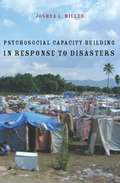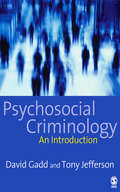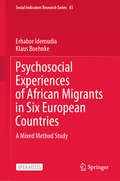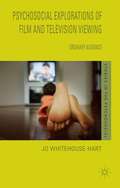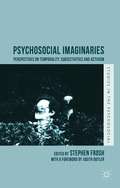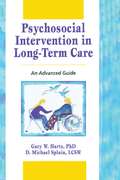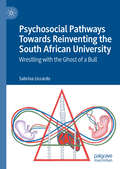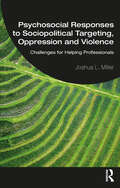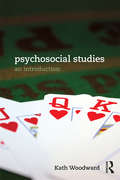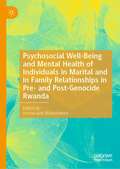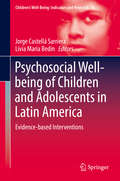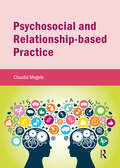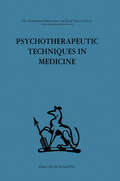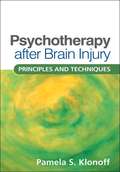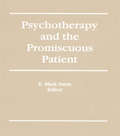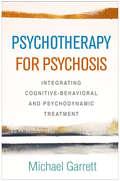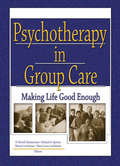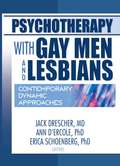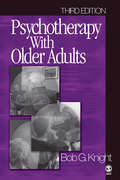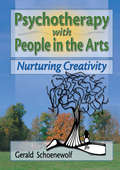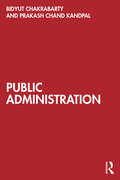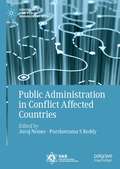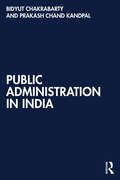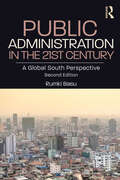- Table View
- List View
Psychosocial Capacity Building in Response to Disasters
by Joshua MillerDisaster responders treat more than just the immediate emotional and psychological trauma of victims: they empower individuals and families to heal themselves long into a disaster's aftermath. This requires helping survivors to rebuild their ability to meet their emotional and psychological needs, not only for themselves but also for others, which necessitates a careful consideration of survivors' social, economic, and political realities as their communities heal and recover.This comprehensive book integrates Western mental health approaches and international models of psychosocial capacity building within a social ecology framework, providing practitioners and volunteers with a blueprint for individual, family, group, and community interventions. Joshua L. Miller focuses on a range of disasters at local, regional, national, and international levels. Global case studies explore the social, psychological, economic, political, and cultural issues affecting various reactions to disaster and illustrate the importance of drawing on local cultural practices to promote empowerment and resiliency. Miller encourages developing people's capacity to direct their own recovery, using a social ecology framework to conceptualize disasters and their consequences. He also considers sources of vulnerability and how to support individual, family, and community resiliency; adapt and implement traditional disaster mental health interventions in different contexts; use groups and activities to facilitate recovery as part of a larger strategy of psychosocial capacity building; and foster collective grieving and memorializing. Miller's text examines the unique dynamics of intergroup conflict and the relationship between psychosocial healing, social justice, and peace and reconciliation. Each chapter ends with a mindfulness exercise, and a section reviews practitioner self-care.
Psychosocial Criminology
by Tony Jefferson Dr David Gadd'This is a well written, thought provoking, and highly challenging book for anyone who claims to be a criminologist or for whom crime is of central concern. It should be required reading on all undergraduate and post-graduate criminology courses. A truly innovative take on some well established criminological dilemmas.' - Sandra Walklate, Eleanor Rathbone Chair of Sociology, University of Liverpool What makes people commit crime? Psychosocial Criminology demonstrates how a psychosocial approach can illuminate the causes of particular crimes, challenging readers to re-think the similarities and differences between themselves and those involved in crime. The book critiques existing psychological and sociological theories before outlining a more adequate understanding of the criminal offender. It sheds new light on a series of crimes - rape, serial murder, racial harassment , 'jack-rolling' (mugging of drunks), domestic violence - and contemporary criminological issues such as fear of crime, cognitive-behavioural interventions and restorative justice. Gadd and Jefferson bring together theories about identity, subjectivity and gender to provide the first comprehensive account of their psychoanalytically inspired approach. For each topic, the theoretical perspective is supported by individual case studies, which are designed to facilitate the understanding of theory and to demonstrate its application to a variety of criminological topics. This important and lucid book is written primarily for upper level undergraduates, postgraduates and teachers of criminology. It is particularly useful for students undertaking a joint degree in criminology and psychology. It will also appeal to critical psychologists, psychoanalysts, students of biographical methods and those pursuing social work training. David Gadd is Senior Lecturer in Criminology at Keele University. Tony Jefferson is Professor of Criminology at Keele University.
Psychosocial Experiences of African Migrants in Six European Countries: A Mixed Method Study (Social Indicators Research Series #81)
by Klaus Boehnke Erhabor IdemudiaThis open access book provides an empirical account of the psychological and social experiences of 3500 African migrants to 6 European countries: Germany, Spain, Italy, The Netherlands, France, and the UK. It discusses the psychosocial motivations for migration from Africa, who migrates where, and stressful pre- and post-migration factors affecting the social and psychological wellbeing of migrants. The book also includes a detailed exploration of posttraumatic stress disorder (PTSD) and posttraumatic stress symptoms (PTSS) among African migrants. Addressing and offering solutions to pre- and post-migration problems in Africa and Europe as well as the problems associated with the perilous journeys involved, this unique study is a must-read for anyone interested in cross-cultural psychology and social science, and particularly in migration and mental health.
Psychosocial Explorations of Film and Television Viewing
by Jo Whitehouse-HartMost people have, at some point in their lives, experienced powerful, often strange and disconcerting, responses to films and television programmes of which they cannot always make sense. Psychosocial Explorations of Film and Television Viewing takes as its subject the seemingly mundane and everyday activity of watching television and films in the home, arguing that the affective and emotional experiences generated for audiences make this activity in fact extraordinary. Based on a fascinating empirical study of audiences' "favourite" films and television programmes, the book unravels the biographical and emotional intensity of viewing, from a psychosocial perspective. Drawing on insights from psychoanalysis including the work of Sigmund Freud, Melanie Klein, Donald Winnicott, Wilfred Bion and Christopher Bollas, and sociological theorists such as Pierre Bourdieu, the book argues that viewing is a psychosocial activity which must consider the relationships and processes between "inner" and "outer" worlds. Important ideas from media audience research are revisited, to show that families and biographical experiences influence audience identification, interpretation and uses of television. The in-depth case studies show that whilst viewing can be pleasurable, in the conventional sense of enjoyment, it can also be anxiety-provoking and contradictory. Employing psychoanalytic methods for social and cultural research, this book is an important contribution to Media Studies, Film Studies, Cultural Studies and Psychosocial Studies.
Psychosocial Imaginaries: Perspectives on Temporality, Subjectivities and Activism (Studies in the Psychosocial)
by Stephen FroshPsychosocial Imaginaries.
Psychosocial Intervention in Long-Term Care: An Advanced Guide
by Gary W Hartz D Michael SplainThe responsibility of providing mental health evaluations and treatment to nursing home patients is increasingly falling on the shoulders of social services and nursing staff. Psychosocial Intervention in Long-Term Care provides the advanced techniques you, as a caregiver, need for assessing and intervening with psychosocial and behavioral problems in LTC. Targeted to students and staff who are familiar with the basic needs and problems of LTC residents, this book also describes effective ways of documenting assessments and interventions to help you integrate results into the medical record and prepare for state surveys. Psychosocial Intervention in Long-Term Care presents you with information about common mental disorders in LTC, basic counseling techniques, and the three major types of psychiatric medication. You’ll also read about legal issues in the psychosocial arena and learn how to avoid burnout while working in LTC. Best of all, this book shows you how to: use the Geriatric Depression Scale and the Mini Mental Status Exam to screen for depression and dementia design thorough behavioral assessments through use of a tracking grid use results of assessments to set up effective behavioral interventions intervene with specific psychosocial problems, such as aggression document the results of assessments develop effective Resident Assessment Inventories prepare for state surveys and develop plans of correction in response to surveysWhether you’re a graduate student or new practitioner in social work, nursing, or health care administration, you’ll appreciate this book’s practical, hands-on approach to problem solving and its focus on the biopsychosocial model. Only through a thorough assessment of residents’physical, psychological, and social needs can we design effective intervention and provide the care they deserve.
Psychosocial Pathways Towards Reinventing the South African University: Wrestling with the Ghost of a Bull
by Sabrina LiccardoThis book proposes a conceptual-empirical framework for exploring forms of continuity and change along psychosocial pathways in South African universities. It illustrates how the psychosocial pathways are grounded in the symbolic narratives and knowledges of young scientists, engineers and architects - all interlocutors in the research from which this book is based. Alala, Mamoratwa, Welile, Odirile, Kaiya, Amirah, Takalani, Nosakhele, Naila, Ambani, Khanyisile, Itumeleng, Ethwasa and Kgnaya provide collective standpoints in the multiplicities within and between the lived lives and told stories of young Black South African women in Science, Technology, Engineering, and Mathematics (STEM) fields. In doing so, this compelling work advances possibilities for demythologising scientific endeavour as a white male achievement and shifting knowledge communities across gendered, racialised, class and national divides.This book presents an innovative narrative methodology, utilising the myth of the Minotaur to examine the state of the university at the heart of the hierarchical labyrinth in “post”-apartheid South Africa. Throughout the work the author wrestles with and self-reflexively highlights her own positionality as a white, middle-class South African woman to examine how this affects the production of this research in ways which serve to preserve the colonial knowledge system. With the rise of the Rhodes Must Fall and Fees Must Fall student movement in South Africa, demanding for the fall of institutionalised racial hierarchies, the author uses the cover image of narrative formations in the spirit of exploration to think with and through undulating networked forms that could possibly forge new psychosocial pathways towards decolonising and reinventing South African universities. This work offers a unique conceptual and methodological resource for students and scholars of psychosocial and narrative theory, as well as those who are concerned about the politics of higher education, both in South Africa and in other contexts around the world.
Psychosocial Responses to Sociopolitical Targeting, Oppression and Violence: Challenges for Helping Professionals
by Joshua L. MillerThis book will prepare social workers, psychologists, and counselors for psychosocial work with individuals and groups who are experiencing distress and trauma resulting from historical and current sociopolitical oppression and violence. Sociopolitical oppression is a sustained, systematic catastrophe, which results from social targeting and discrimination such as racism, sexism and misogyny, homophobia, and anti-immigrant fervor. The consequences are profound and debilitating. In some ways, they are similar to reactions to a single event disaster (e.g., hurricane, earthquake, terrorist attack) but even more insidious because the social targeting and harassment have been ongoing and will continue. As a guide for direct clinical practice, this book offers new models for understanding the nature and consequences of sociopolitical disasters as well as guiding a range of interventions – clinical, psychoeducational, advocacy, and social justice – for use on a micro, mezzo, and macro level. Drawing on indigenous and BIPOC knowledge and scholarship and using case studies from around the world, it criticizes while also adapting and integrating knowledge and theory from the fields of disaster mental health, psychosocial capacity building, trauma therapy, psychodynamic theory, cognitive behavioral theories, and theories of resilience and positive psychology, linking them to an understanding of historical and social oppression, social justice, and intergroup conflict and reconciliation. The book offers critiques of dominant Western, Eurocentric visions of personhood and models of intervention and questions assumptions about the roles of "client" and "worker," proposing more egalitarian, collaborative relationships and extensive use of training of trainers. It will prepare graduate students and practitioners across the helping professions for work that promotes the collective and individual strength and efficacy of affected people, while also responding directly to vulnerability, stress, and trauma.
Psychosocial Studies: An Introduction
by Kath WoodwardThere is expanding global interest in the relationship between the psychological and the social. The bringing together of affect, emotion and feeling with social, political and cultural forces offers a creative, innovative and rich set of ways of understanding what Charles Wright Mills called the links between personal troubles and public issues. This book is an introduction to psychosocial studies. Drawing on different approaches to the field, the book introduces the main theoretical influences on psychosocial studies and their development and impact, through – for example – concepts such as the unconscious, self and identity, affect, emotion and the cultural and social unconscious. It explores the theoretical frameworks of psychosocial studies, and psychosocial research methods. The book offers examples of case studies which illustrate the diversity of psychosocial studies and what makes it distinctive. It asks: what is social about the inner worlds of the psychological? What is psychological and psychic about social worlds and social life? This clear, accessible introduction will be of interest to students and researchers across the social sciences and humanities, in particular in sociology, psychology, cultural geography, social policy and politics and cultural studies.
Psychosocial Well-Being and Mental Health of Individuals in Marital and in Family Relationships in Pre- and Post-Genocide Rwanda
by Immaculée MukashemaThis book provides an in-depth examination of psychosocial marital well-being and mental health in traditional communities in Rwanda. It presents rich qualitative research conducted with men, women and elders, highlighting both the issues impacting on marital conflict and domestic violence, and also how potential solutions might be drawn from traditional practices. In doing, so it provides a unique resource for researchers and policymakers seeking to develop evidence-based and culturally-informed mental health and psychosocial support interventions in low and middle income countries. It will appeal in particular to those working the fields of public health, family psychology, social work, cross-cultural psychology and qualitative methodology.
Psychosocial Well-being of Children and Adolescents in Latin America: Evidence-based Interventions (Children’s Well-Being: Indicators and Research #16)
by Jorge Castellá Sarriera Lívia Maria BedinThis book discusses child well-being, with children and adolescents as key informants, from a Latin American perspective. It explores theoretical and empirical issues related to well-being and associated aspects, in order to understand the well-being of this population. Topics analyzed in this volume address for instance environment and community, rights, leisure time, technologies, interpersonal relationships and spirituality and their implications for changes in the well-being in children and adolescents. Especially relevant for scholars and professionals in the social and health sciences, as well as policy makers, seeking to promote child well-being, regardless of the area in which they operate.
Psychosocial and Relationship-based Practice (Critical Approaches to Social Work)
by Claudia MegeleSocial work is fundamentally a relationship-based profession. This book offers a critical multidisciplinary analysis of case studies of social work interventions from a psychosocial and relationship-based perspective.Providing a description of each case, it draws on psychodynamic theory, object relations theory, attachment theory, relational psychoanalysis, and sociological theories and research to present a critical interdisciplinary analysis of the dynamics and the outcomes of each case. This offers the reader a holistic and practical psychosocial and relationship-based perspective in thinking about and analysing each case, and offers a host of learning that is immediately relevant to the readers’ own practice.This book serves as a contemporary, integrated, and highly valuable reference and resource for social work students and practitioners as well as students and practitioners from allied professions, such as health, occupational therapists, nursing, psychotherapy and counselling, who may be interested in a psychosocial and relationship-based understanding of their own cases and interaction with their own clients/user of services.
Psychotherapeutic Techniques in Medicine
by Michael Balint Enid BalintTavistock Press was established as a co-operative venture between the Tavistock Institute and Routledge & Kegan Paul (RKP) in the 1950s to produce a series of major contributions across the social sciences. This volume is part of a 2001 reissue of a selection of those important works which have since gone out of print, or are difficult to locate. Published by Routledge, 112 volumes in total are being brought together under the name The International Behavioural and Social Sciences Library: Classics from the Tavistock Press. Reproduced here in facsimile, this volume was originally published in 1961 and is available individually. The collection is also available in a number of themed mini-sets of between 5 and 13 volumes, or as a complete collection.
Psychotherapy after Brain Injury
by Pamela KlonoffThis book presents hands-on tools for addressing the multiple ways that brain injury can affect psychological functioning and well-being. The author is a leader in the field who translates her extensive clinical experience into clear-cut yet flexible guidelines that therapists can adapt for different challenges and settings. With a focus on facilitating awareness, coping, competence, adjustment, and community reintegration, the book features helpful case examples and reproducible handouts and forms. It shows how to weave together individual psychotherapy, cognitive retraining, group and family work, psychoeducation, and life skills training, and how to build and maintain a collaborative therapeutic relationship.
Psychotherapy and the Promiscuous Patient
by E Mark SternLearn effective strategies for therapy with promiscuous patients from this in-depth exploration of the phenomenon of promiscuity in the lives and backgrounds of patients seeking psychotherapy. This unique book features insights about the pitfalls of patients who cannot bear commitment to any one person, or who jeopardize their commitments with a need to spark their lives with promiscuity. Psychotherapy and the Promiscuous Patient teaches psychotherapists to respond to their patients’promiscuous behavior as a symptom of a problem, not the problem itself. A realm of aspects of promiscuity are explored within the psychiatric context. Promiscuity is very broadly defined in fascinating examinations of adult promiscuity as a result of childhood sexual abuse, hypersexuality in adult males, addiction to the sensation of “falling in love,” career promiscuity, and even psychotherapy as an uncommon “promiscuity’--a nonexclusive, altruistic love. Timely chapters confront the changing distinctions between promiscuity and sex addiction and challenge readers to uncover the various emotional needs met by promiscuity in order to protect patients from their self-destructive behavior. Knowledgeable practicing psychotherapists relate methods for dealing with patients’constant restlessness and working with a variety of patients in an intimate setting. Psychotherapy and the Promiscuous Patient contains invaluable strategies that can be directly applied to practice including: the use of narrative construction and reconstruction as treatment for sexually promiscuous clients a self-psychological approach to treatment the importance of confusion as an introduction to change in therapy a method of self-investigation applied to promiscuous behavior the implications of the clinical meaning and therapeutic use of strong-laughter outbursts in psychology a self-psychology perspective on transference to therapistsPsychotherapy and the Promiscuous Patient is a valuable clinical book for psychotherapists, and it offers an across the board appeal to a wide variety of psychiatrists and related social scientists who are interested in today’s shifting moral climate. It is also an ideal supplemental text for an introductory methods or applications in psychiatry course.
Psychotherapy for Psychosis: Integrating Cognitive-Behavioral and Psychodynamic Treatment
by Michael GarrettIn this innovative book, master clinician Michael Garrett shows how to weave together cognitive-behavioral therapy (CBT) and psychodynamic therapy to support the recovery of persons suffering from psychosis. This integrated framework builds on the strengths of both methods to achieve lasting gains, even for patients with severe, chronic mental illness. The therapist is guided to use CBT to help the patient recognize the literal falsity of delusions, while employing psychodynamic strategies to explore the figurative truth and personal meaning of psychotic symptoms. Extended case presentations and numerous clinical vignettes illustrate Garrett’s compassionate, empowering approach.
Psychotherapy in Group Care: Making Life Good Enough
by D Patrick Zimmerman Richard A. Epstein Jr Martin Leichtman Maria LeichtmanIntegrate psychotherapy with residential treatment to achieve positive results for patients in group care! This book addresses the complex issues that arise in the effort to provide individual therapy in group care settings. It reviews classical case material, presents contemporary case studies, and examines practical and theoretical issues important to the effective delivery of treatment to individuals living in residential care. Noted experts who have been associated with The Sonia Shankman Orthogenic School at the University of Chicago and the Menninger Clinic in Topeka, Kansas, share knowledge garnered from years of real-world experience to help you stay at the leading edge of the field and provide effective individual treatment to your clients in long- and short-term residential care. Psychotherapy in Group Care: Making Life Good Enough includes practical and theoretical chapters exploring important aspects of the group care paradigm. The book: presents a case study that describes vital aspects of the analytic process that emerged in work with an adolescent boy in a group home who felt as though he was a psychological orphan illustrates the role of play as a continuous and basic function in therapy and presents play-themed vignettes from analytic work with two young people in residential care revisits "Joey: A Mechanical Boy" and "Tommy the Space Child"-classic case studies from Bruno Bettelheim and Rudolph Ekstien-and explores the implications of contemporary relational theory for using the meaning and metaphor of behaviors and communications addresses issues of transference and counter-transference in the psychodynamic psychotherapy of a young girl in residential care-with a discussion of unrecognized rescue fantasies and projective identification, and of the need for residential childcare workers to recognize and work through the difficult feelings evoked in the process of working with seriously disturbed young people examines the structural basis for the integration of psychotherapy and residential treatment, considering the meaning of integration, variables that affect the manner and degree to which integration can be accomplished, and changes in the psychotherapists' roles that can maximize the potential of each variable explores three sets of theoretical issues facing clinicians as they play multiple roles in short-term residential treatment, discussing how conflicts in the roles of therapists and team leaders can be resolved, the implications of such a resolution in terms of confidentiality, and ways in which major approaches to psychotherapy can be adapted to new conditions considers the role of the primary clinician in relation to the residential team and explores the ways in which integration of psychotherapy and residential treatment can be implemented in the early phase of the treatment process
Psychotherapy with Gay Men and Lesbians: Contemporary Dynamic Approaches
by Jack Drescher Ann D'Ercole Erica SchoenbergExamine gay and lesbian psychoanalysis from a variety of perspectives! Psychotherapy with Gay Men and Lesbians: Contemporary Dynamic Approaches presents case histories of psychotherapy sessions with gay and lesbian patients, focusing on today's psychoanalytical approaches. Dedicated to enhancing the emotional, psychological, and psychiatric treatment of gay men, lesbians, and bisexuals, the book features prominent analysts with a wide range of clinical and theoretical approaches. The foremost experts in the therapeutic field address issues affecting gay and lesbian patients from psychoanalytic perspectives that respect the patients' sexual identities. Psychotherapy with Gay Men and Lesbians reflects the significant clinical and theoretical changes therapists face in dealing with issues of gender and sexuality. New ways of thinking coexist with traditional theory as paradigm shifts in psychotherapy and psychoanalysis affect the treatment of gay, lesbian, and bisexual patients. This book provides a forum to address those changes through clinical papers and discussions. Psychotherapy with Gay Men and Lesbians includes discussion of case reports that deal with: gay therapists treating gay patients countertransferential enactments of sex and gender in treatment rethinking the meanings of homosexuality psychotherapeutic treatment of gay male patients with AIDS and much more! Psychotherapy with Gay Men and Lesbians is an essential forum for the exchange of clinical information on gay and lesbian psychotherapy. The book is a valuable resource for psychiatrists, psychologists, social work therapists, psychoanalysts, and anyone interested in today's psychoanalytic approaches to homosexuality.
Psychotherapy with Infants and Young Children
by Patricia Van Horn Alicia LiebermanThis eloquent book presents an empirically supported treatment that engages parents as the most powerful agents of their young children's healthy development. Child-parent psychotherapy promotes the child's emotional health and builds the parent's capacity to nurture and protect, particularly when stress and trauma have disrupted the quality of the parent-child relationship. The book provides a comprehensive theoretical framework together with practical strategies for combining play, developmental guidance, trauma-focused interventions, and concrete assistance with problems of living. Filled with evocative, "how-to-do-it" examples, it is grounded in extensive clinical experience and important research on early development, attachment, neurobiology, and trauma.
Psychotherapy with Older Adults
by Bob G. KnightThis Third Edition of the bestselling Psychotherapy with Older Adults continues to offer students and professionals a thorough overview of psychotherapy with older adults. Using the contextual, cohort-based, maturity, specific challenge (CCMSC) model, it draws upon findings from scientific gerontology and life-span developmental psychology to describe how psychotherapy needs to be adapted for work with older adults, as well as when it is similar to therapeutic work with younger adults. Sensitively linking both research and experience, author Bob G. Knight provides a practical account of the knowledge, technique, and skills necessary to work with older adults in a therapeutic relationship. This volume considers the essentials of gerontology as well as the nature of therapy in depth, focusing on special content areas and common themes.
Psychotherapy with People in the Arts: Nurturing Creativity
by Terry S Trepper Gerald SchoenewolfLearn to free creativity from the shackles of emotional conflicts!This riveting collection of case histories illustrates the dark interplay of neurosis and creativity. Psychotherapy with People in the Arts explores the struggles of writers, painters, actors, and composers to reconcile their overwhelming need to create and the self-doubts, frustrations, and neuroses that block their potential. In addition to ten inspiring tales of healing and self-knowledge, Psychotherapy with People in the Arts provides a solid introduction to the primary issues related to emotional disorders and creativity. It begins with a study of the notoriously reclusive and eccentric writer J. D. Salinger. Using both theory and case example, it shows how family history, present relations, and genetics can combine to impede the flow of an artist&’s natural gifts-and how a good therapist can help unblock that creative power. It also includes a series of tests to diagnose blocked creativity. Psychotherapy with People in the Arts explores such compelling themes as: dealing with racism and internalized self-hatred the conflict between commercial and high art anger and blocked tears the drive for an impossible perfection emotional alienation and sexual acting outPsychotherapy with People in the Arts is a fascinating look at a complex and controversial subject. Though not everyone is a professional artist, every human being has creative potential that can be blocked by emotional disturbances. And every therapist, mental health educator, and artist will find rich sources of information and inspiration in this book. Visit the author's website at http://www.livingcenter.net
Public Administration
by Bidyut Chakrabarty Prakash Chand KandpalThis textbook is a comprehensive, student-friendly guide to understanding the fundamentals of public administration. It examines the recent developments and relevant theoretical underpinnings in an accessible manner.Public Administration: Helps students grasp key dialectical interconnections between theoretical conceptualizations and prevalent socio-economic and political circumstances Provides understanding of issues in governance Analyses significant transformations in civil society and administrative set-ups across the world Highlights the contributions of non-Western thinkers in the development of conceptual ideas of the discipline Accessibly written, it caters to a wide range of university syllabi in public administration and will be essential for students and researchers of political science, public policy and public administration. It will also be particularly useful for those preparing for the civil service examinations.
Public Administration in Conflict Affected Countries (Governance and Public Management)
by Juraj Nemec Purshottama S ReddyThis book highlights the main factors determining the quality of public administration in conflict affected countries; and assesses to what extent the conflict determines and impacts on the performance of public administration in affected countries. The main value added by this book is confirming the general expectation that there is no direct and universal link between the conflict and public administration performance (and vice-versa). One may need to argue that each country situation differs and specific factors of internal and external environments determine the trends of public administration performance in conflict affected countries. To achieve the overarching goal of the book, sixteen country studies were developed from all relevant continents - America, Africa, Asia and Europe: Bangladesh, Colombia, Croatia, Egypt, Georgia, Iraq, Kosovo, Nigeria, Palestine, Paraguay, Philippines, Serbia, South Africa, Uganda, Ukraine, and Venezuela.
Public Administration in India
by Bidyut Chakrabarty Prakash Chand KandpalThis textbook is essential reading for undergraduate and postgraduate students of Public Administration, Political Science and UPSC aspirants. Lucid, accessible and student-friendly Public Administration in India: Familiarizes students with the theory, practice and evolution of Indian administration through contextual analysis Adopts a multi-disciplinary approach in discussing the traditional and emerging issues of the Indian administration Focuses on the processes of administration with reference to their constitutional provisions as well as socio-economic and political contexts; and Highlights new issues and challenges in the field of public administration in India through critical analysis of its growth and development since Independence This book will be key reading for the candidates appearing for various civil service examinations as well as for students and researchers of political science and public administration.
Public Administration in the 21st Century: A Global South Perspective
by Rumki BasuPublic Administration has experienced a fundamental rethinking of its basic objectives, concepts, and theories during the 21st century.This book examines transformations happening in global societies, the economy, and in politics, to trace the trajectory of public administration as an academic discipline, as well as being a focus of social science research. It presents a reassessment of governance in heterogeneous developing countries that goes beyond the traditional Weberian bureaucratic model, toward new models of organization and management informed by their legal, constitutional, economic, and political needs, aspirations, and ground realities. This is especially important in relation to the marginalized sections of society that primarily rely on citizen entitlements through public service delivery systems. The author looks at widening the range and scope of public administrative agencies with the gradual cooperation of multiple actors, such as civil society, people at large, and even the private sector, in a partnering role. The author revisits the discipline to tackle intellectual dilemmas that current governance theories and practices are confronting or will have to confront in future administrative situations in the context of developing countries of the South.In the second edition, the volume brings into focus lessons on policy and governance learnt from the Global South in building administrative capacities in post-Covid-19 times. An essential read on the mandates and challenges for the state regarding the rising South, this book will be indispensable to scholars and researchers of politics, especially governance and public policy, sociology, and development studies. It will also be of interest to bureaucrats, NGOs, and government officials.
